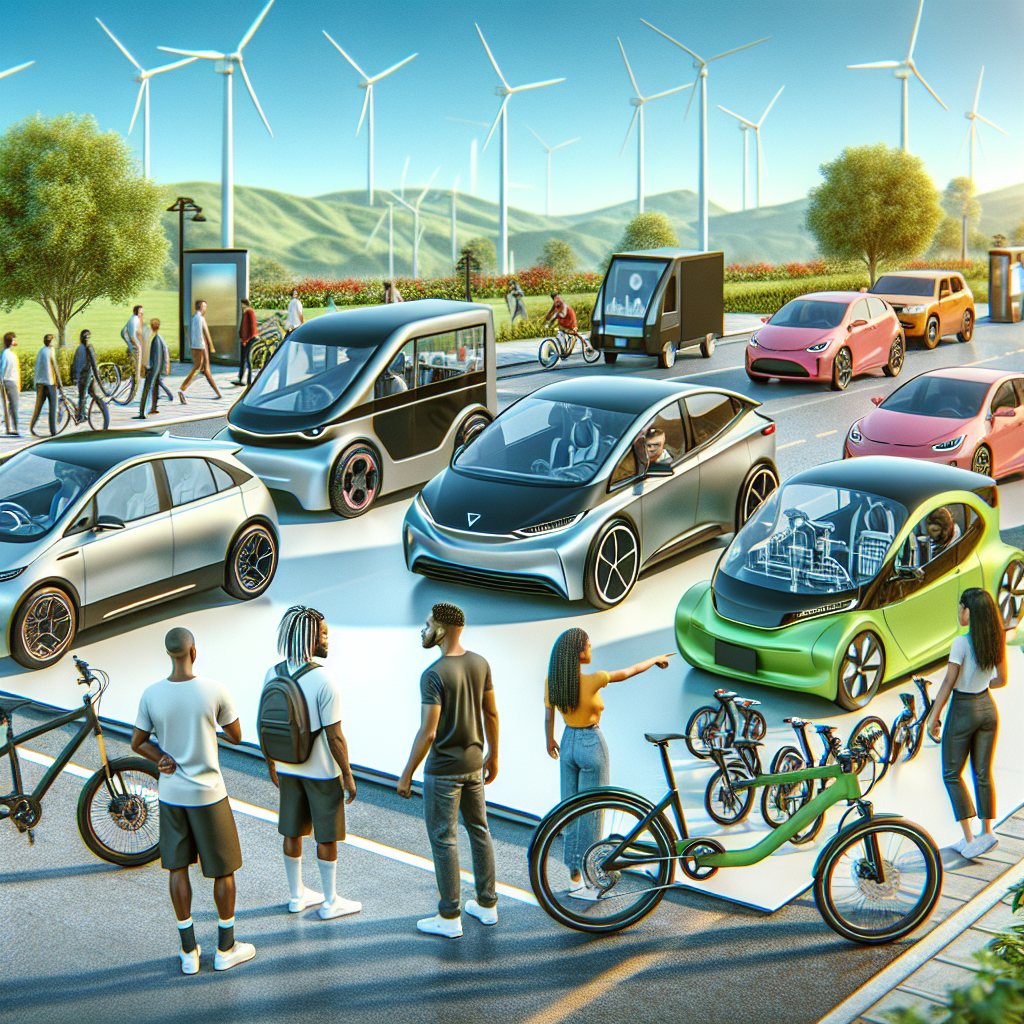-
Table of Contents
“Drive the Future: Unleash the Power of Electric Vehicles”
Introduction

Electric vehicles (EVs) represent a transformative shift in the automotive industry, offering a range of benefits that extend beyond mere transportation. As concerns about climate change and environmental sustainability intensify, EVs emerge as a viable solution to reduce greenhouse gas emissions and reliance on fossil fuels. These vehicles operate on electric power, which can be sourced from renewable energy, thereby significantly lowering the carbon footprint. Additionally, EVs offer economic advantages, including lower operating and maintenance costs compared to traditional internal combustion engine vehicles. The advancement in battery technology and the expansion of charging infrastructure further enhance the practicality and appeal of electric vehicles. This exploration delves into the multifaceted benefits of EVs, encompassing environmental, economic, and technological perspectives, and underscores their potential to revolutionize the future of transportation.
Environmental Impact of Electric Vehicles
Electric vehicles (EVs) have emerged as a pivotal innovation in the quest for sustainable transportation, offering a promising solution to the environmental challenges posed by traditional internal combustion engine vehicles. As the world grapples with the pressing need to reduce greenhouse gas emissions and combat climate change, the environmental impact of electric vehicles warrants a closer examination. This exploration reveals a multifaceted array of benefits that extend beyond mere reductions in tailpipe emissions.
To begin with, one of the most significant environmental advantages of electric vehicles is their potential to drastically cut down on carbon dioxide emissions. Unlike conventional vehicles that burn fossil fuels and release carbon dioxide as a byproduct, EVs operate on electricity, which can be generated from renewable sources such as wind, solar, and hydroelectric power. This shift from gasoline to electricity can lead to a substantial decrease in the overall carbon footprint of the transportation sector. According to a study by the Union of Concerned Scientists, electric vehicles produce less than half the emissions of comparable gasoline-powered cars over their lifetime, even when accounting for the emissions from electricity generation.
Moreover, electric vehicles contribute to improved air quality, particularly in urban areas where traffic congestion and pollution are prevalent. Traditional vehicles emit a range of pollutants, including nitrogen oxides and particulate matter, which are known to cause respiratory problems and other health issues. By eliminating tailpipe emissions, EVs help to reduce the concentration of these harmful pollutants in the air, leading to cleaner and healthier cities. This improvement in air quality can have profound public health benefits, potentially reducing the incidence of asthma, lung disease, and other pollution-related conditions.
In addition to their direct environmental benefits, electric vehicles also play a crucial role in promoting energy independence and security. The reliance on oil for transportation fuels has long been a source of geopolitical tension and economic vulnerability. By transitioning to electric vehicles, countries can reduce their dependence on imported oil and instead utilize domestically produced electricity. This shift not only enhances national energy security but also supports the growth of local renewable energy industries, fostering economic development and job creation.
Furthermore, the environmental impact of electric vehicles extends to their potential for integration with smart grid technologies. As the adoption of EVs increases, they can be leveraged as mobile energy storage units, capable of feeding electricity back into the grid during peak demand periods. This bidirectional flow of energy can help to stabilize the grid, enhance the efficiency of electricity distribution, and facilitate the integration of intermittent renewable energy sources. Consequently, electric vehicles can contribute to a more resilient and sustainable energy infrastructure.
However, it is important to acknowledge that the environmental benefits of electric vehicles are not without challenges. The production of EV batteries involves the extraction and processing of raw materials such as lithium, cobalt, and nickel, which can have significant environmental and social impacts. Additionally, the disposal and recycling of batteries pose further environmental concerns. Addressing these issues requires concerted efforts to develop more sustainable battery technologies, improve recycling processes, and ensure responsible sourcing of materials.
In conclusion, the environmental impact of electric vehicles is overwhelmingly positive, offering a pathway to reduced greenhouse gas emissions, improved air quality, enhanced energy security, and a more resilient energy grid. While challenges remain, the continued advancement of technology and policy measures aimed at mitigating these issues will be crucial in realizing the full environmental potential of electric vehicles. As society moves towards a more sustainable future, the role of electric vehicles in shaping a cleaner and greener world cannot be overstated.
Cost Savings with Electric Vehicles
As the world increasingly turns its attention to sustainable practices, electric vehicles (EVs) have emerged as a promising solution to reduce carbon emissions and combat climate change. However, beyond their environmental benefits, electric vehicles offer significant cost savings that make them an attractive option for consumers. These savings manifest in various forms, from reduced fuel expenses to lower maintenance costs, and collectively contribute to the growing appeal of EVs.
One of the most immediate and noticeable cost savings associated with electric vehicles is the reduction in fuel expenses. Traditional internal combustion engine (ICE) vehicles rely on gasoline or diesel, both of which are subject to fluctuating prices and can represent a substantial portion of a driver’s monthly budget. In contrast, electric vehicles are powered by electricity, which is generally cheaper and more stable in price. Charging an EV at home, especially during off-peak hours, can result in significant savings over time. For instance, the cost per mile for an electric vehicle is often a fraction of that for a gasoline-powered car, leading to considerable savings over the lifespan of the vehicle.
In addition to fuel savings, electric vehicles also benefit from lower maintenance costs. The design of an electric vehicle is inherently simpler than that of a traditional car, primarily because it has fewer moving parts. An electric motor, for example, has only one moving part compared to the hundreds found in an internal combustion engine. This simplicity translates to fewer opportunities for mechanical failure and, consequently, lower maintenance and repair costs. Routine maintenance tasks such as oil changes, which are necessary for ICE vehicles, are entirely eliminated with EVs. Furthermore, the regenerative braking systems in electric vehicles reduce wear and tear on brake components, extending their lifespan and reducing the frequency of replacements.
Another area where electric vehicles offer cost savings is through various government incentives and rebates. Many countries and states provide financial incentives to encourage the adoption of electric vehicles. These incentives can take the form of tax credits, rebates, or reduced registration fees, all of which can significantly lower the initial purchase price of an EV. Additionally, some regions offer perks such as access to carpool lanes and free or discounted parking, further enhancing the financial attractiveness of electric vehicles.
Moreover, the long-term financial benefits of electric vehicles are becoming increasingly apparent as battery technology advances. The cost of EV batteries, which has historically been a significant barrier to widespread adoption, has been steadily decreasing. As battery prices continue to fall, the overall cost of electric vehicles is expected to become more competitive with traditional cars. Additionally, improvements in battery technology are leading to longer driving ranges and shorter charging times, making EVs more practical and appealing to a broader audience.
While the initial purchase price of an electric vehicle may still be higher than that of a comparable ICE vehicle, the total cost of ownership often tells a different story. When factoring in fuel savings, lower maintenance costs, government incentives, and the decreasing cost of batteries, electric vehicles can offer substantial financial benefits over their lifespan. As consumers become more aware of these cost savings, the adoption of electric vehicles is likely to accelerate, further driving down prices and making EVs an even more attractive option.
In conclusion, the cost savings associated with electric vehicles extend beyond just the price at the pump. With reduced fuel expenses, lower maintenance costs, government incentives, and advancements in battery technology, electric vehicles present a compelling financial case for consumers. As the market for EVs continues to grow and evolve, these cost benefits will play a crucial role in shaping the future of transportation.
Technological Advancements in Electric Vehicles
Electric vehicles (EVs) have emerged as a pivotal innovation in the automotive industry, driven by technological advancements that promise to revolutionize transportation. As the world grapples with the pressing need to reduce carbon emissions and combat climate change, the shift towards electric mobility is not merely a trend but a necessity. The benefits of electric vehicles extend beyond environmental sustainability, encompassing economic, technological, and societal dimensions.
One of the most significant technological advancements in electric vehicles is the development of high-capacity batteries. These batteries, often lithium-ion based, have seen substantial improvements in energy density, charging speed, and overall efficiency. This progress has directly addressed one of the primary concerns of potential EV buyers: range anxiety. Modern electric vehicles can now travel distances comparable to their gasoline counterparts on a single charge, making them a viable option for long-distance travel. Furthermore, the advent of fast-charging infrastructure has alleviated concerns about lengthy charging times, allowing drivers to recharge their vehicles in a matter of minutes rather than hours.
In addition to battery technology, advancements in electric motor efficiency have played a crucial role in enhancing the performance of electric vehicles. Electric motors are inherently more efficient than internal combustion engines, converting a higher percentage of energy from the battery into usable power. This efficiency translates into lower operating costs for EV owners, as electric vehicles require less energy to travel the same distance compared to traditional vehicles. Moreover, the simplicity of electric motors, with fewer moving parts, results in reduced maintenance requirements and longer vehicle lifespans.
The integration of smart technology and connectivity in electric vehicles has further amplified their appeal. Modern EVs are equipped with advanced driver-assistance systems (ADAS), autonomous driving capabilities, and sophisticated infotainment systems. These features not only enhance the driving experience but also contribute to overall safety and convenience. For instance, real-time data from connected vehicles can optimize route planning, reduce traffic congestion, and improve energy efficiency. Additionally, over-the-air software updates ensure that EVs remain up-to-date with the latest technological advancements without the need for physical modifications.
Economic benefits also play a significant role in the growing adoption of electric vehicles. Governments worldwide are offering incentives such as tax credits, rebates, and subsidies to encourage the purchase of EVs. These financial incentives, coupled with the decreasing cost of batteries and other components, have made electric vehicles more affordable for consumers. Furthermore, the lower operating and maintenance costs of EVs contribute to long-term savings, making them an economically attractive option.
The societal impact of electric vehicles cannot be overlooked. By reducing reliance on fossil fuels, EVs contribute to improved air quality and public health. Urban areas, in particular, stand to benefit from decreased emissions of pollutants such as nitrogen oxides and particulate matter, which are linked to respiratory and cardiovascular diseases. Additionally, the widespread adoption of electric vehicles can stimulate job creation in various sectors, including manufacturing, infrastructure development, and renewable energy.
In conclusion, the technological advancements in electric vehicles have paved the way for a sustainable and efficient future in transportation. The benefits of EVs extend beyond environmental considerations, encompassing economic advantages, enhanced performance, and societal well-being. As technology continues to evolve, the potential for electric vehicles to transform the automotive landscape becomes increasingly evident. The transition to electric mobility is not just a technological shift but a comprehensive movement towards a cleaner, healthier, and more sustainable world.
Government Incentives for Electric Vehicle Adoption
As the world grapples with the pressing need to address climate change and reduce greenhouse gas emissions, governments around the globe are increasingly turning to electric vehicles (EVs) as a viable solution. To accelerate the adoption of EVs, various government incentives have been introduced, ranging from financial subsidies to non-monetary benefits. These incentives are designed to make electric vehicles more accessible and appealing to consumers, thereby fostering a transition away from traditional internal combustion engine vehicles.
One of the most significant incentives offered by governments is the provision of financial subsidies. These subsidies often come in the form of tax credits or rebates, which can substantially reduce the upfront cost of purchasing an electric vehicle. For instance, in the United States, the federal government offers a tax credit of up to $7,500 for the purchase of a new EV, depending on the battery capacity. Similarly, several European countries, including Germany and France, provide generous grants and rebates to encourage consumers to opt for electric vehicles. These financial incentives play a crucial role in bridging the price gap between EVs and their gasoline-powered counterparts, making them a more attractive option for a broader range of consumers.
In addition to direct financial incentives, governments are also implementing policies that indirectly promote the adoption of electric vehicles. For example, many cities have introduced low-emission zones where only electric or hybrid vehicles are allowed to enter, effectively restricting access for traditional vehicles. This not only incentivizes the purchase of EVs but also contributes to improved air quality in urban areas. Furthermore, some governments offer benefits such as reduced registration fees, exemption from road taxes, and lower toll charges for electric vehicle owners. These measures collectively enhance the cost-effectiveness of owning an EV over its lifetime.
Another critical aspect of government incentives is the investment in charging infrastructure. The availability of a robust and widespread charging network is essential for alleviating range anxiety, a common concern among potential EV buyers. To this end, governments are allocating substantial funds to expand public charging stations and support the development of fast-charging technology. For instance, the European Union has set ambitious targets for the installation of charging points across member states, while the United States has launched initiatives like the National Electric Vehicle Infrastructure (NEVI) program to build a comprehensive charging network. By ensuring that charging facilities are readily accessible, governments are addressing one of the primary barriers to EV adoption.
Moreover, governments are also focusing on fostering innovation and research in the electric vehicle sector. By providing grants and subsidies to manufacturers and research institutions, they are encouraging the development of advanced battery technologies, which can lead to longer driving ranges and shorter charging times. This, in turn, enhances the overall appeal of electric vehicles and accelerates their adoption. Additionally, some governments are implementing stringent emission regulations and setting ambitious targets for phasing out internal combustion engine vehicles, thereby creating a regulatory environment that favors the growth of the EV market.
In conclusion, government incentives play a pivotal role in promoting the adoption of electric vehicles. Through a combination of financial subsidies, policy measures, investment in infrastructure, and support for innovation, governments are making significant strides in encouraging consumers to make the switch to electric vehicles. These efforts not only contribute to reducing greenhouse gas emissions and combating climate change but also pave the way for a more sustainable and environmentally friendly transportation system. As the momentum for electric vehicles continues to build, it is evident that government incentives will remain a key driver in shaping the future of mobility.
Conclusion
In conclusion, exploring the benefits of electric vehicles (EVs) reveals significant advantages in terms of environmental impact, economic savings, and technological advancements. EVs contribute to reduced greenhouse gas emissions and lower air pollution, promoting a cleaner and healthier environment. Economically, they offer lower operating and maintenance costs compared to traditional internal combustion engine vehicles, along with potential savings from government incentives and reduced fuel expenses. Technologically, the development of EVs drives innovation in battery technology, energy storage, and renewable energy integration. As infrastructure and technology continue to improve, the adoption of electric vehicles is poised to play a crucial role in the transition to a more sustainable and efficient transportation system.




